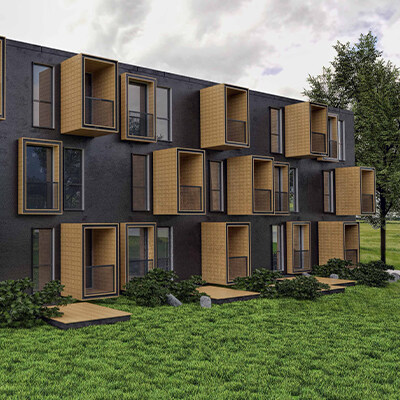Email format error
Email cannot be empty
Email already exists
6-20 characters(letters plus numbers only)
The password is inconsistent
Email format error
Email cannot be empty
Email does not exist
6-20 characters(letters plus numbers only)
The password is inconsistent


In the realm of modern construction, steel frame technology has revolutionized the way commercial buildings, including supermarkets, are designed and built. This article explores the comparative advantages of steel frame construction over traditional methods, recent innovations in steel frame technology tailored for supermarket environments, essential design considerations, and the regulatory and safety standards that govern these structures.
Cost Comparison
When considering the construction of supermarkets, cost-effectiveness plays a pivotal role. Steel frame construction often proves to be more economical compared to traditional materials like concrete or wood. The upfront costs of steel may seem higher, but its advantages in terms of quicker construction timelines and reduced labor costs often offset these initial expenses. Moreover, the durability of steel frames translates to lower maintenance costs over the building's lifespan, further enhancing cost-effectiveness.
Environmental Impact
In an era increasingly focused on sustainability, steel frame construction stands out for its environmental benefits. Steel is highly recyclable, with a significant portion of steel used in construction coming from recycled sources. This recyclability not only reduces landfill waste but also minimizes the environmental impact associated with extracting raw materials for traditional building materials. Additionally, steel frames can contribute to energy-efficient building designs, supporting efforts to achieve green building certifications such as LEED (Leadership in Energy and Environmental Design).
Longevity and Durability
Supermarkets, with their high traffic and varied environmental conditions, require structures that can withstand wear and tear over extended periods. Steel frames excel in durability, offering superior resistance to pests, rot, and fire compared to wood. They also maintain structural integrity better in adverse weather conditions, ensuring a longer lifespan for the building. The longevity of steel frames reduces the need for frequent repairs and replacements, making them a sustainable choice for long-term investment in supermarket construction.

Advanced Materials
Recent advancements in steel alloys have enhanced the performance of steel frames in supermarket construction. New alloys offer increased strength and durability while reducing the weight of structural components. Lightweight yet robust steel frames not only simplify construction logistics but also enable innovative architectural designs that were previously challenging with traditional materials.
Construction Techniques
Prefabrication and modular construction techniques have further streamlined the use of steel frames in supermarket projects. Prefabricated steel components are manufactured off-site under controlled conditions, ensuring high quality and precision. This method reduces on-site construction time significantly, minimizing disruption to surrounding areas and speeding up project completion. Modular construction using steel frames allows for flexible building configurations and easier scalability, accommodating future expansions or modifications as supermarket needs evolve.
Layout Optimization
Designing the layout of a supermarket involves maximizing space efficiency and optimizing customer flow. Steel frames offer flexibility in layout design, allowing architects to create open-plan interiors with minimal internal columns. This design freedom enhances visibility across the store, improves navigation for shoppers, and facilitates efficient stocking and restocking operations. Additionally, the lightweight nature of steel frames supports larger spans, enabling expansive interior spaces that enhance the shopping experience.
Interior Design Trends
Steel frames lend themselves to various interior design aesthetics, from industrial chic to modern minimalism. Exposed steel beams and columns can become architectural features, adding a contemporary flair to supermarket interiors. Interior designers can play with textures and finishes that complement the structural elements, creating visually appealing spaces that resonate with modern consumer preferences. Functional considerations, such as integrating ergonomic checkout counters and optimizing product display areas, further enhance the overall design coherence and user experience.
Customer Flow Considerations
Effective supermarket design prioritizes the seamless flow of customers through the store. Steel frame construction supports the creation of well-defined circulation paths that guide shoppers from entrance to checkout smoothly. Strategically placed aisles, shelving units, and product displays ensure optimal traffic flow, reducing congestion during peak hours. Designing with customer convenience in mind enhances satisfaction and encourages repeat visits, reinforcing the economic viability of supermarkets built with steel frames.
Industry Regulations
Adherence to local building codes and regulations is essential for any construction project, including those utilizing steel frames for supermarkets. Building codes stipulate specific requirements for structural integrity, fire resistance, and occupancy safety that steel frame designs must meet. Compliance ensures the safety and security of occupants and protects against potential liabilities associated with building failures or accidents.
Safety Protocols
During both construction and occupancy phases, stringent safety protocols govern steel frame supermarket projects. Construction teams follow industry standards for assembling and erecting steel frames safely, including protocols for handling heavy materials and operating machinery. Once operational, supermarkets must adhere to safety measures for public spaces, such as emergency exit routes, fire suppression systems, and accessibility accommodations. Compliance with safety standards not only safeguards occupants but also enhances the reputation and reliability of supermarket operators.
In conclusion, steel frame construction offers compelling advantages for building supermarkets, ranging from cost-effectiveness and sustainability to enhanced design flexibility and safety. Recent innovations in steel frame technology continue to expand the possibilities for creating efficient, durable, and aesthetically pleasing supermarket environments. By integrating advanced materials, innovative construction techniques, thoughtful design considerations, and strict adherence to regulatory standards, steel frame supermarkets can meet the evolving demands of modern consumers while ensuring long-term operational success and community relevance.